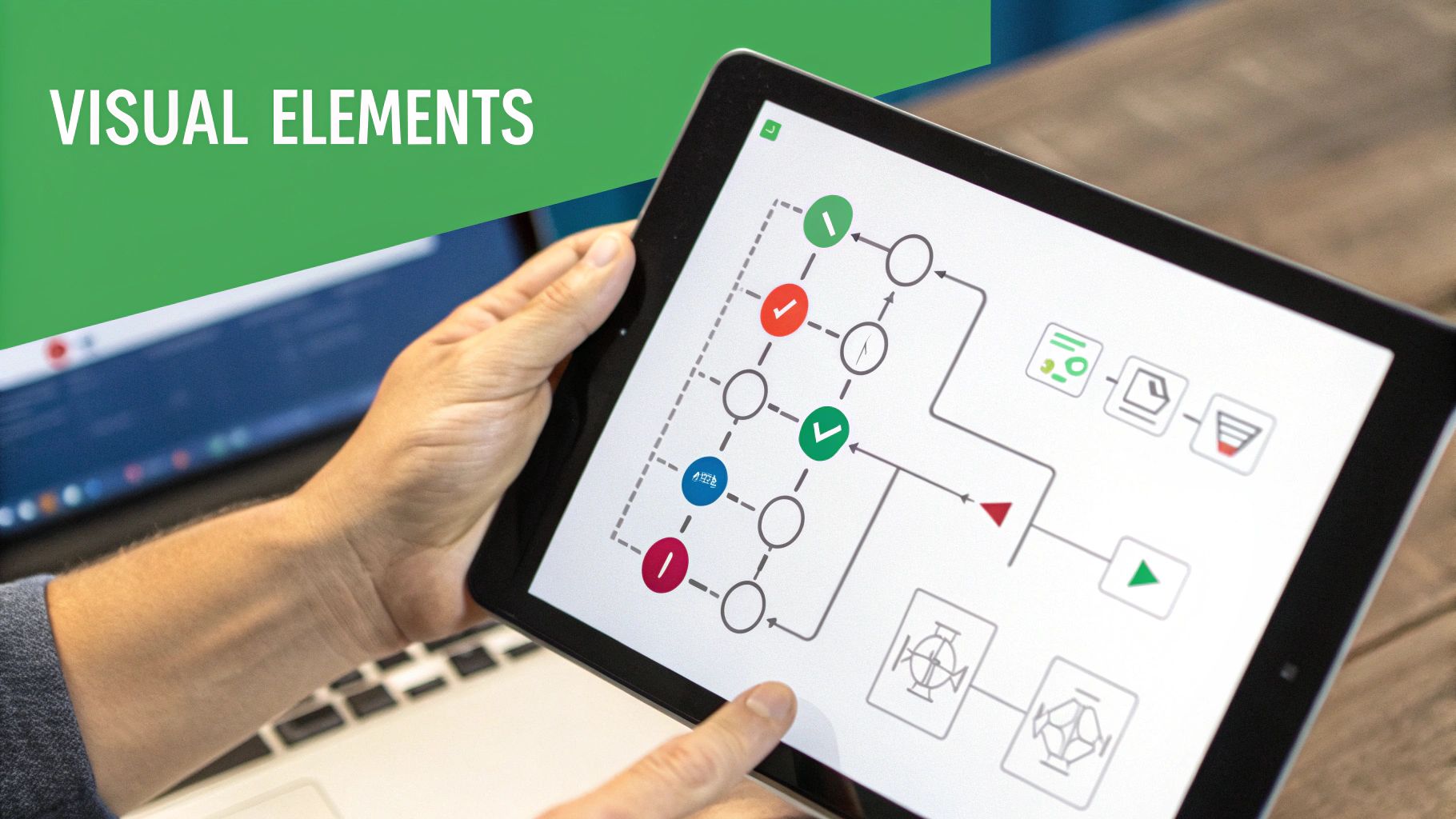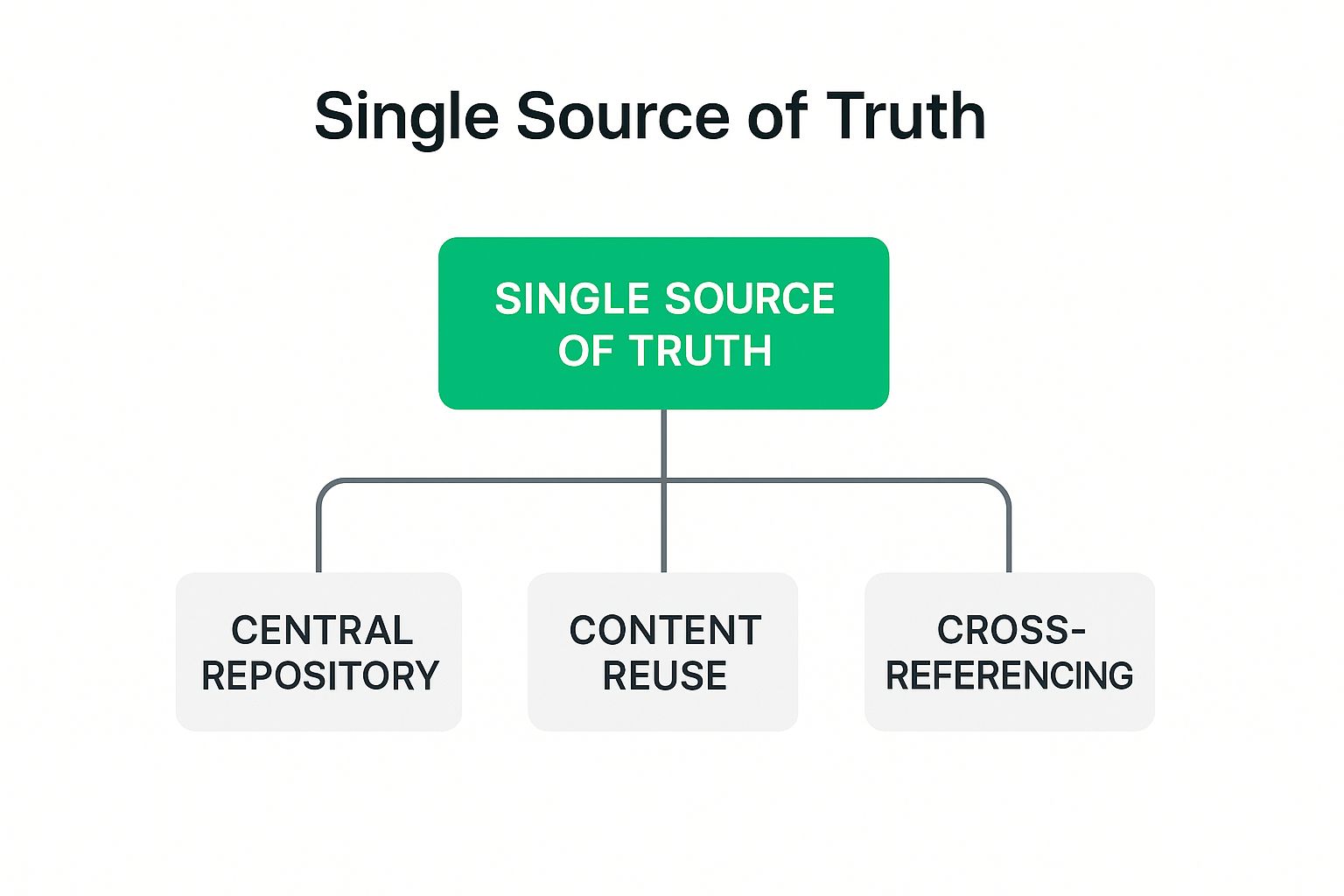Discover essential documentation best practices to create clear, user-friendly content that boosts understanding and satisfaction in 2025.
Good documentation saves time, reduces support costs, and improves user satisfaction. This listicle presents eight documentation best practices to transform your docs from a burden into a valuable asset. Whether you’re building software, a website, or an app, these tips will streamline your workflow and improve product usability. Learn how to implement version control, write for your target audience, design for searchability, and more. Mastering these documentation best practices ensures your projects are well-documented and easily understood, regardless of complexity.
Consistent structure is a cornerstone of effective documentation best practices. It introduces predictability and enhances navigation, allowing users to easily locate and understand the information they need. This means adhering to the same format across all sections of your documentation, employing predictable headers, a logical content organization, and consistent navigation elements. This predictability reduces the cognitive load on users as they don’t need to constantly re-orient themselves to a new layout or style every time they access a different part of the documentation. It allows them to focus on understanding the content, rather than deciphering the structure. This, in turn, improves the overall user experience and encourages engagement with the documentation.

This approach relies on several key features: standard templates for different document types (e.g., tutorials, API references, troubleshooting guides), a consistent heading hierarchy (H1, H2, H3, etc.), predictable navigation patterns (e.g., sidebars, breadcrumbs), and uniform formatting and styling (fonts, colors, code blocks). For example, a tutorial might always start with a brief overview, followed by a step-by-step guide, and conclude with a summary and next steps.
The benefits of implementing a consistent structure are numerous. It reduces the cognitive load for readers, making the documentation more scannable and easier to digest. This improved user experience leads to increased user satisfaction and adoption. Furthermore, consistent structure simplifies maintenance and updates. When all documentation follows the same format, it’s easier to identify and correct inconsistencies, add new content, and ensure overall quality.
However, enforcing a rigid structure can also present some challenges. It can be restrictive for unique content needs where a standard template might not be suitable. The initial creation of templates and style guides requires an upfront time investment. Maintaining consistency also requires regular reviews and audits to ensure the established structure is being followed.
Several successful companies exemplify the power of consistent documentation structure. Microsoft’s documentation, spanning a vast range of products, maintains a recognizable structure and style. Google’s developer documentation also exhibits uniform patterns, making it easy for developers to navigate across different APIs and platforms. Stripe’s API documentation, with its clear and consistent organization, has become a recognized industry standard.
To implement consistent structure in your own documentation, consider the following tips:
This structured approach is essential for any software project, regardless of size. Whether you’re a startup, a small business owner, a freelancer, or part of a large engineering team, prioritizing consistent documentation structure will improve the usability and effectiveness of your documentation, contributing to the overall success of your project. It deserves its place at the top of the documentation best practices list because it lays the foundation for all other best practices to be effective. Without a solid structure, even the most well-written content can be lost in a disorganized and confusing mess.
One of the most crucial documentation best practices is tailoring your content to the specific needs of your audience. Effective documentation doesn’t adopt a one-size-fits-all approach. Instead, it recognizes that different users have varying levels of technical expertise, distinct goals, and unique contexts in which they’ll be utilizing the documentation. By understanding your target audience, you can craft content that speaks directly to their requirements, improving comprehension and maximizing the documentation’s overall effectiveness. This targeted approach ensures that users find the information they need quickly and easily, leading to a more positive user experience.

This principle hinges on several key features: conducting thorough audience analysis and developing user personas, employing tailored technical vocabulary, providing context-appropriate examples, and structuring the documentation with a user-centered approach. For instance, documentation for developers requires a different level of technical depth and vocabulary compared to documentation intended for end-users. A developer might need detailed API specifications and code samples, while an end-user would benefit from clear, concise instructions and step-by-step tutorials.
Examples of successful implementation of this principle are readily apparent in leading tech companies. Twilio segments its documentation for developers and business users, recognizing the distinct needs of each group. Apple provides separate technical documentation for developers and user-friendly guides for everyday consumers. Atlassian employs a tiered documentation approach catering to admins, users, and developers, reflecting the diverse roles and responsibilities within their ecosystem. These examples highlight the value of audience-focused documentation in enhancing user experience and product adoption.
Tips for Writing for Your Audience:
Pros:
Cons:
This approach deserves a prominent place in the list of documentation best practices because it directly impacts the effectiveness and usability of the documentation. By focusing on the specific needs of the target audience, this method ensures that the documentation serves its intended purpose: to empower users to effectively utilize the product or service. The insights from experts like Sarah Maddox and Tom Johnson, as featured on the “I’d Rather Be Writing” blog, further underscore the importance of this practice in achieving high-quality documentation. While catering to different audiences may present challenges in terms of development and maintenance, the benefits of increased user comprehension and satisfaction far outweigh the costs.
Version control is a crucial documentation best practice that significantly improves content quality, collaboration, and maintainability. It’s a system for tracking changes to files over time, allowing you to revert to specific versions later if needed. This practice is essential for modern development teams, especially in the context of rapidly evolving software projects. By implementing version control for your documentation, you ensure accuracy, transparency, and a reliable historical record of how information has evolved.
How Version Control Works for Documentation:
Version control systems, such as Git, function as a centralized repository for your documentation. Each modification is recorded as a commit, capturing who made the change, when, and the specific alterations. This detailed history allows for easy tracking of progress and identification of the source of any issues. Furthermore, branching and merging capabilities facilitate parallel work on documentation by multiple contributors. Teams can create separate branches for new features or revisions, work independently, and then seamlessly merge their changes back into the main branch when ready.
Features and Benefits of Version Control for Documentation:
These features translate into tangible benefits for your documentation process:
Examples of Successful Implementation:
Several organizations successfully leverage version control for their documentation, demonstrating the effectiveness of this practice:
Actionable Tips for Implementing Version Control:
Pros and Cons:
While version control offers significant benefits, there are also a few considerations:
Pros: Preserves history, enables collaboration, provides accountability, reduces data loss risk, facilitates reviews. Cons: Learning curve for non-technical contributors, potential merge conflicts, added complexity for simple projects.
When and Why to Use Version Control:
Version control is essential for any documentation project, especially when:
Learn more about Implement Version Control for a deeper dive into version control best practices. This approach is a cornerstone of modern documentation best practices, empowering teams to create high-quality, maintainable, and collaborative documentation. This practice is highly recommended for software developers, software engineers, tech startups, small business owners, freelancers, engineering teams, web developers, app developers, and DevOps teams.
In the realm of documentation best practices, incorporating visual elements is paramount for enhancing comprehension and engagement. Visuals such as diagrams, screenshots, and videos serve to break up large blocks of text, illustrate complex concepts, and cater to diverse learning styles. Effective visuals can significantly reduce the time required to understand information and improve its retention, contributing to more effective documentation.

This approach leverages the power of visual learning, offering a complementary method of understanding alongside textual explanations. Specific visual elements that can be employed include process flow diagrams to outline workflows, annotated screenshots to clarify interface interactions, instructional videos for demonstrating procedures, interactive examples to allow users to experiment, and infographics to present complex data in a digestible format. This variety allows for tailoring the visual aid to the specific information being conveyed.
The benefits of including visual elements are substantial. They improve the understanding of complex concepts, particularly for visual learners. They transcend language barriers, making the documentation accessible to a wider audience. Visuals also contribute to making documentation more scannable, enabling users to quickly locate the information they need. Moreover, visuals enhance the retention of information, leading to a more lasting impact. Examples of successful implementations include AWS’s use of architecture diagrams in their documentation, Miro’s visual-first approach to product documentation, and MongoDB’s interactive console examples. These examples demonstrate the diverse applications of visual elements across different types of technical documentation.
However, incorporating visuals also presents certain challenges. Maintaining these visuals requires effort when the user interface or processes change. Visuals can increase file size and load times, necessitating optimization strategies. Creating high-quality visuals might require specialized skills, and accessibility considerations are crucial, such as providing alt text for all images.
To effectively utilize visual elements in your documentation, consider the following tips: Maintain a consistent visual style throughout your documentation to create a cohesive experience. Always provide alt text for all images to ensure accessibility for users with visual impairments. Create templates for common diagram types to streamline the creation process. Diligently update screenshots when interfaces change to maintain accuracy. Finally, always combine visuals with concise text explanations to provide context and reinforce understanding.
Including visual elements earns its place among documentation best practices due to its profound impact on comprehension and engagement. By carefully considering the features, benefits, and potential drawbacks, and by implementing the suggested tips, you can leverage the power of visuals to create truly effective and user-friendly documentation. This is particularly crucial for target audiences like software developers, engineers, tech startups, and small businesses where clear and concise documentation is vital for product adoption and efficient use.
In the realm of documentation best practices, maintaining a single source of truth (SSOT) is paramount. This approach ensures that all information is defined and stored in one central location and reused across your entire documentation suite. This methodology drastically reduces duplication of effort, prevents inconsistencies, and streamlines updates significantly. When information needs modification, it’s updated in only one place, guaranteeing all references remain current and accurate, saving time and reducing the risk of errors. This is particularly crucial for software developers, engineers, tech startups, and small businesses where accurate and up-to-date documentation is essential for both internal teams and external users.

The infographic above visualizes the hierarchical relationship between different aspects of maintaining a single source of truth, with “Single Source of Truth” at the top. Underneath, we see the core benefits—consistency, maintainability, and unified information—branching out. These benefits then further connect to the positive outcomes they deliver, such as reduced effort, accurate information, and streamlined updates. Finally, the diagram shows how these outcomes contribute to the overall goal of improved user experience and efficiency. The diagram emphasizes the cascading effect of implementing a single source of truth, highlighting how this central practice leads to various improvements across the documentation process.
Features facilitating a SSOT approach include content reuse mechanisms (like variables, snippets, and includes), central repositories for common elements like style guides and glossaries, a preference for cross-referencing over content duplication, and a component-based documentation architecture. This modular approach allows individual sections of documentation to be created and reused in various contexts, further enhancing efficiency and consistency.
Examples of Successful Implementation:
When and Why to Use This Approach:
SSOT is especially beneficial for projects with:
Implementing a SSOT approach from the beginning avoids future headaches related to inconsistencies and outdated information.
Tips for Implementing SSOT: